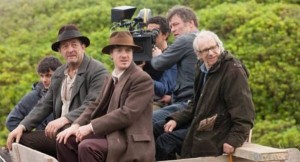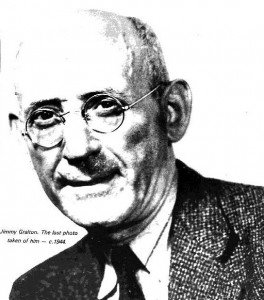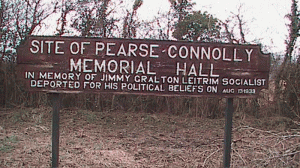Film Review: Jimmy’s Hall
 Film: Jimmy’s Hall.
Film: Jimmy’s Hall.
Production Company: Sixteen Films and Element Productions.
Director: Ken Loach
Release date: 30th May 2014.
Reviewer: Cathal Brennan
Jimmy’s Hall is the new film from Ken Loach about the deportation of Leitrim communist James Gralton in 1933. The Irish Story has previously covered the Anti – Jazz Campaign in Leitrim in 1934 , and while there are similarities, the Gralton case is ultimately a far sadder and depressing reflection on Irish society at the time. The film is based on Donal O’Kelly’s play Jimmy Gralton’s Dancehall and O’Kelly has a small role as a Roscommon IRA activist involved in resisting evictions. The screenplay was written by Loach’s regular colaborator Paul Laverty, who also wrote the screenplay for The Wind That Shakes the Barley.
Jimmy Gralton was a republican and communist activist who was deported from the Irish Free State in 1933
The latter film was a complex and interesting take on the War of Independence and the Civil War. It attempted to portray the labour and socialist strands of the era, which had been sorely overlooked in previous films about that period. The most vociferous criticism of the film at the time came from Irish commentators such as Ruth Dudley Edwards and Eoghan Harris. A lot of this stemmed from distaste for Ken Loach’s left – wing politics. Edwards condemned the film in the Daily Mail and the Guardian while writing that she hadn’t seen the film and didn’t intend to.
The fact that the main character is an anti – Treatyite and that his opposition to the Treaty is treated with empathy was controversial to an established view in Irish popular culture that rejection of the Treaty was motivated by either madness or malevolence. The theme of revolution betrayed is one Loach returns to in Jimmy’s Hall. Connolly’s warning that to have a political revolution without a social revolution would merely mean changing the colour of the flag never seemed more apt than in the early years of the Free State.

The story of James Gralton is one that would not be widely known outside of the left or those with an interest in the history of the early years of the Free State. I first came across him in the Communist Party of Ireland – Outline History .
Gralton was from a poor farming background and emigrated to the United States as a young man. He took out US citizenship but returned to Ireland in the weeks leading up to the Truce in 1921. Black and Tans had burned down the local community hall and he offered to build a new one on his family’s land.
With the collapse of the state in the period of the Truce and the Civil War, disputes, particularly land disputes, were brought to a revolutionary court in the new Pearse – Connolly Memorial Hall with Gralton frequently adjudicating. A wave of working – class militancy and rural discontent was sweeping through the country and Gralton’s activism on behalf of evicted families and landless labourers made many enemies among conservatives and propertied interests in the region. The new Provisional Government sought to arrest him but he evaded National Army troops and returned to the United States. In New York he became active in the Communist Party and in the formation of the Transport Workers Union, alongside other exiled Republicans such as Mike Quill from Kerry.
Director Ken Loach has previously tackled the Irish independence struggle in The Wind that Shakes the Barley, now he takes on clerical power in the post-independence Irish Free State
The 1932 general election saw the pro – Treaty government of Cumann na nGaedheal defeated by Fianna Fáil. After ten years of self government in the Free State there was a strong desire for a more progressive approach to issues such as housing, employment and social welfare. The conservative economic policies of W.T. Cosgrave’s government had failed to deal with emmigration and the poverty affecting large parts of the country, particularly in Connacht. This was compounded by deeply unpopular decisions such as the shilling cut in old age pensions.
With his old enemies out of power Gralton returned to his native Leitrim to look after his elderly parents and the family farm following the death of his brother. Unlike the film, both of Gralton’s parents were alive at the time (his father would die the day before Gralton’s deportation order was issued.) Gralton initially joined Fianna Fáil upon his return but his radical views led him to resign before he was inevitably expelled.
He then set up a branch of the Revolutionary Workers Group in Leitrim and his political agitation, combined with the hall being used for dances, classes and meetings, led to clerical condemnation and attacks from groups such as the Blueshirts.
Loach’s film concentrates on the people of Gralton’s village and the dispute over the hall. The initial freedom and confidence the people get from organising lectures and classes, learning Irish, discussing poetry and socialising free from the constrictive gaze of the Church is replaced by the relentless grind of clerical condemnation and social ostracism. The film is a powerful denunciation of the stultifying atmosphere of the time where challenging the supremacy of the Church, in post Eucharistic Congress Ireland, could lead to unemployment and the emigrant boat, if not physical harm.
In 1931 the Cumann na nGaedheal government hadsought to enlist the support of the Catholic Church in promoting a red scare throughout the country.
In 1931 the Cumann na nGaedheal government hadsought to enlist the support of the Catholic Church in promoting a red scare throughout the country. The 1932 election campaign saw the government attempt to portray Fianna Fáil as a Trojan horse for communism and de Valera as an Irish Kerensky who would be swept aside by more radical elements within the republican movement who sought to create an Irish soviet government .
The obsession that sections of society had with the potential of a Bolshevik take over appears, in hindsight, ludicrous at a time when communist membership numbered in the hundreds. This didn’t stop violent attacks on Connolly House and the Workers College (by what were described as Army Comrade Association and Animal Gang mobs) and blood curdling sermons from pulpits throughout the state.

The film references the 1932 unemployment riots which crossed the sectarian divisions in Belfast to protest against the paltry welfare provisions from Stormont. The movement was led by the Revolutionary Workers Groups and during the protests the Northern Ireland government had British commmunist Tom Mann deported from the north. This example was to lead Gralton’s enemies to seek to have him deported to America on account of him having taken out US citizenship.
Jim Norton’s parish priest, Father Sheridan, is a somewhat sympathetic portrayal of a man conflicted by his respect, and grudging admiration of Gralton, with what he sees as his duty to combat communism and impose the authority of the Church on the community. In reality, Father O’Dowd (upon whom Fr. Sheridan is based) comes across as anything but sympathetic in his dealings with Gralton and his supporters.
Jimmy Gralton set up a community hall which was burned down by an anti-communist mob in 1932, armed with shotguns and revolvers.
He warned his parishoners that those attending the hall did so at their own risk and warned them not to blame him for what might happen. This was combined with threats that those seeking relief work in future wouldn’t get any from him. Whether inspired by O’Dowd’s condemnations or not in December of 1932, shotguns and revolvers were used during an attack on the hall as a céilí was taking place but thankfully no one was injured. The Hall was eventually burned down on Christmas Eve.
After the deportation order was signed, Gralton managed to evade capture for six months. It’s only briefly alluded to in the film but his case became a popular cause among radicals at time. Defence committees were formed and support was voiced from some trade unions, Labour Party and even Fianna Fáil branches. Peadar O’Donnell and Seán Murray went to nearly Drumsna to organise a church gate meeting after mass but were attacked by a mob led by local parish priest Father Cosgrave. The IRA was split on the issue but despite some statements in Gralton’s defence, ultimately did nothing.
Jimmy’s Hall is an interesting and thought provoking film. The issues of cowardice, political hypocrisy and subservience are still as relevant today as they were in 1933
Gralton was eventually caught and deported to the United States. The money he had in his pocket was taken to pay his fare. His elderly mother was prevented from seeing him before he left. He became the first and only Irish man to be deported from the country after independence. The hypocrisy involved in his case is best summed up by the local Fianna Fáil TD, Ben Maguire, who stated, ‘Deportation of an Irishman requires investigation, but deportation of a person propagating English ideas was a desirable thing.’ Gralton died in New York in 1945, never having been allowed to return to his native land.
Jimmy’s Hall is an interesting and thought provoking film. While it might not become as controversial as previous films he has made which dealth with Irish themes, such as The Wind That Shakes The Barley or Hidden Agenda, the issues of cowardice, political hypocrisy and subservience are still as relevant today as they were in 1933.